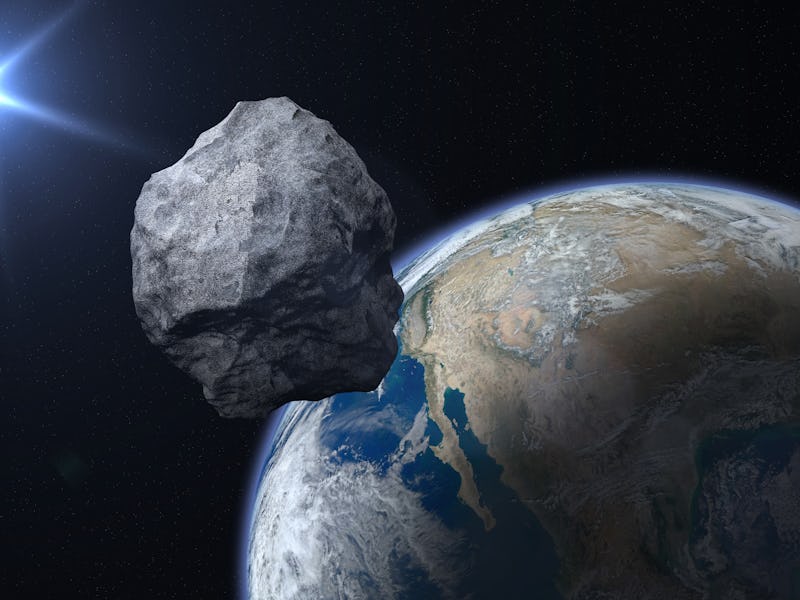An asteroid will come within 2,200 miles of Earth tonight — here’s why you shouldn’t worry
Most space rocks are never a threat to our planet.

Every week, there seems to be another asteroid in the news that’s about to fly dangerously close to Earth. But it never comes near enough to smash our planet to smithereens — or even quietly burn up in the atmosphere.
This week it’s asteroid 2023 BU, which will soar just 2,200 miles above Earth’s surface on January 26, according to NASA. That’s well within the range of artificial satellites, and about 236,655 miles closer to Earth than the Moon.

The orbit of 2023 BU.
To be fair, 2023 BU wouldn’t be a planet-killer even if it did breach the atmosphere, thanks to its small size. But NASA says that this will be one of the closest recorded encounters a near-Earth object has ever made.
So are we on an amazing streak of luck, or is the threat of a dangerous impact grossly overhyped?
The truth lies somewhere in the middle. Data from NASA and other agencies show that close encounters with space objects aren’t that rare, though some could pose a real threat.
How common are near-Earth asteroids?
The prospect of a killer asteroid or comet hitting Earth is a very real fear — hence the popularity of movies like Armageddon, Deep Impact, and Don’t Look Up. And when there’s a real-life space object coming close to Earth, you won’t have to look far to find headlines about it.
Not every near-Earth object makes it into the news though, since there are literally tens of thousands known to pass close by our planet. NASA defines near-Earth objects (NEOs) as natural space objects that orbit within 1.3 astronomical units (AU) of the Sun. Earth itself is one AU from the Sun, which equals roughly 150 million miles.
NEOs are a group consisting of all the natural objects that come close to our planet — namely asteroids and comets. The vast majority are asteroids, and they range in size from a few meters wide to more than one kilometer.
To date, over 31,000 near-Earth asteroids alone have been recorded by NASA’s Center for Near Earth Object Studies.
Total near-Earth asteroids recorded by NASA’s Center for Near Earth Object Studies from 1980 to today.
Over time, more and more asteroids have been detected, thanks to advances in monitoring technology. It’s likely that many of the space objects we know about today were quietly flying by Earth decades before we even discovered them.
Small asteroids, like 2023 BU, sometimes aren’t seen until just days before they approach our planet. But the big objects are easier to spot — which is good news, because they sometimes pose more of a threat.
The watch list
It’s not just size that makes an asteroid or comet a potential risk for planet Earth. Researchers also have to assess an object’s orbit and speed in order to estimate where it’s headed.
NASA and the European Space Agency keep lists of asteroids that are estimated to one day collide with or come very close to our planet. The ESA’s risk list has 1,443 objects of note, though it tracks both big and small Earth-bound objects — some too small to even make it through the atmosphere.
NASA’s Sentry monitoring system tracks 27 high-risk asteroids. One of the most likely strikers is Bennu, a craggy space rock that’s projected to hit Earth sometime between the years 2178 and 2290.
The near-Earth asteroid Bennu.
Recent probability estimates put the chance of Bennu impacting Earth at 1 in 1,750. And if Bennu does beat the odds, it doesn’t mean planetary doom is inevitable.
Low chance of impact
Last year, NASA successfully changed the orbit of the near-Earth asteroid Didymos during its DART mission. The experiment’s success will likely pave the way for even more robust planetary defense systems in the future.
But beyond a handful of NEOs, most space objects coming close to Earth will never pose an existential threat.
On NASA’s Sentry website, the agency warns that “an Earth collision by a sizable NEA is a very low probability event.” And predictions can change with new data, rendering once-threatening asteroids harmless.
When asteroids come close to Earth, you’re much, much more likely to be faced with a good skywatching opportunity than literal armageddon.
This article was originally published on